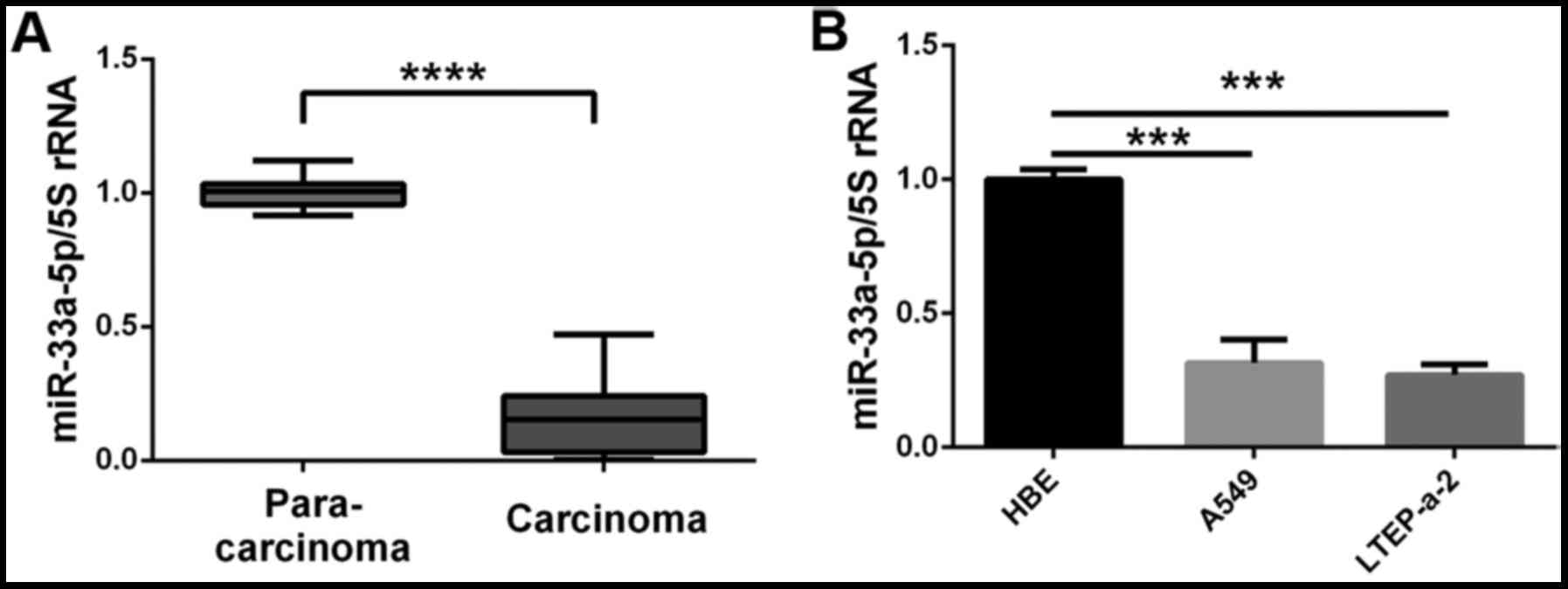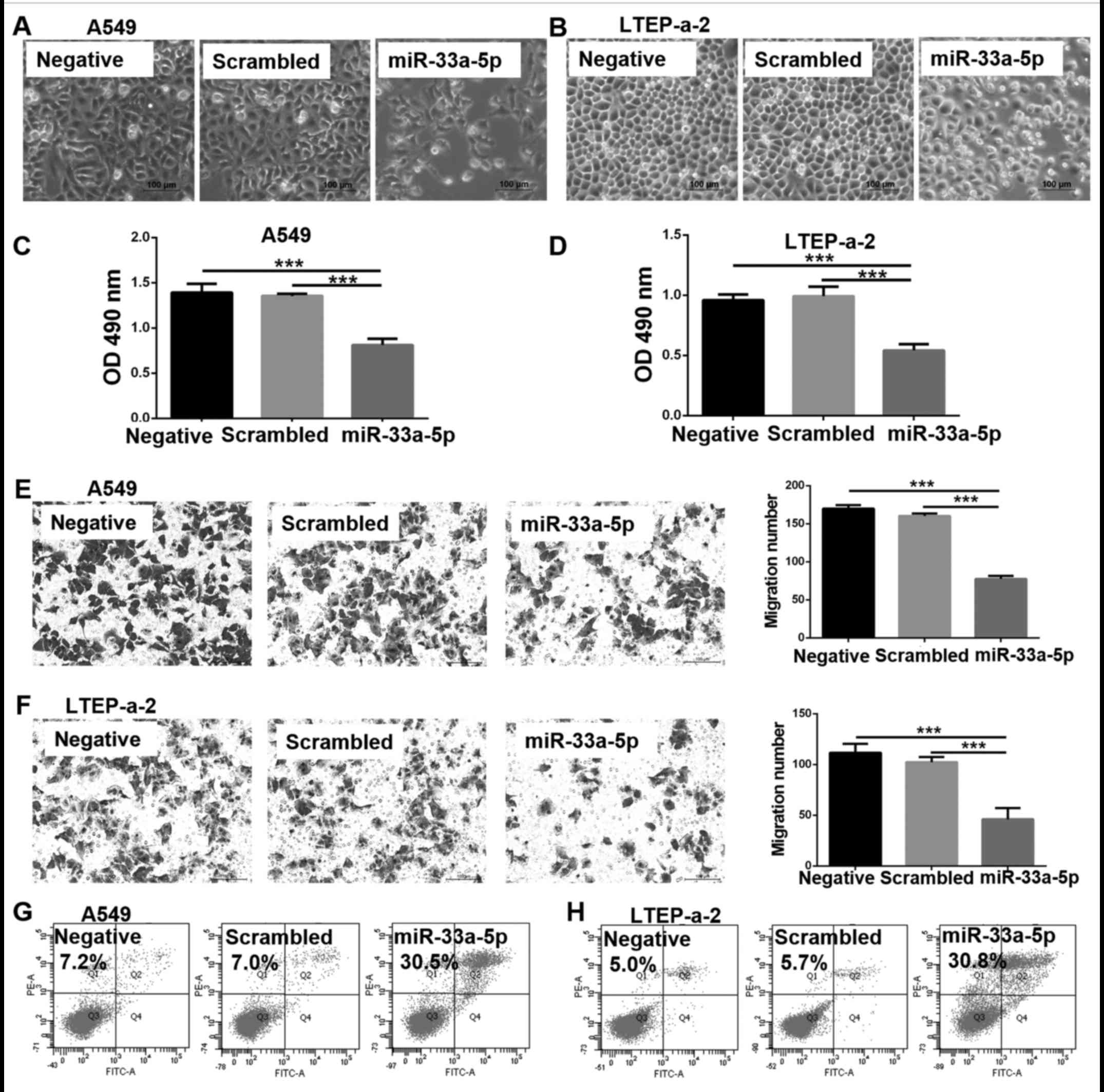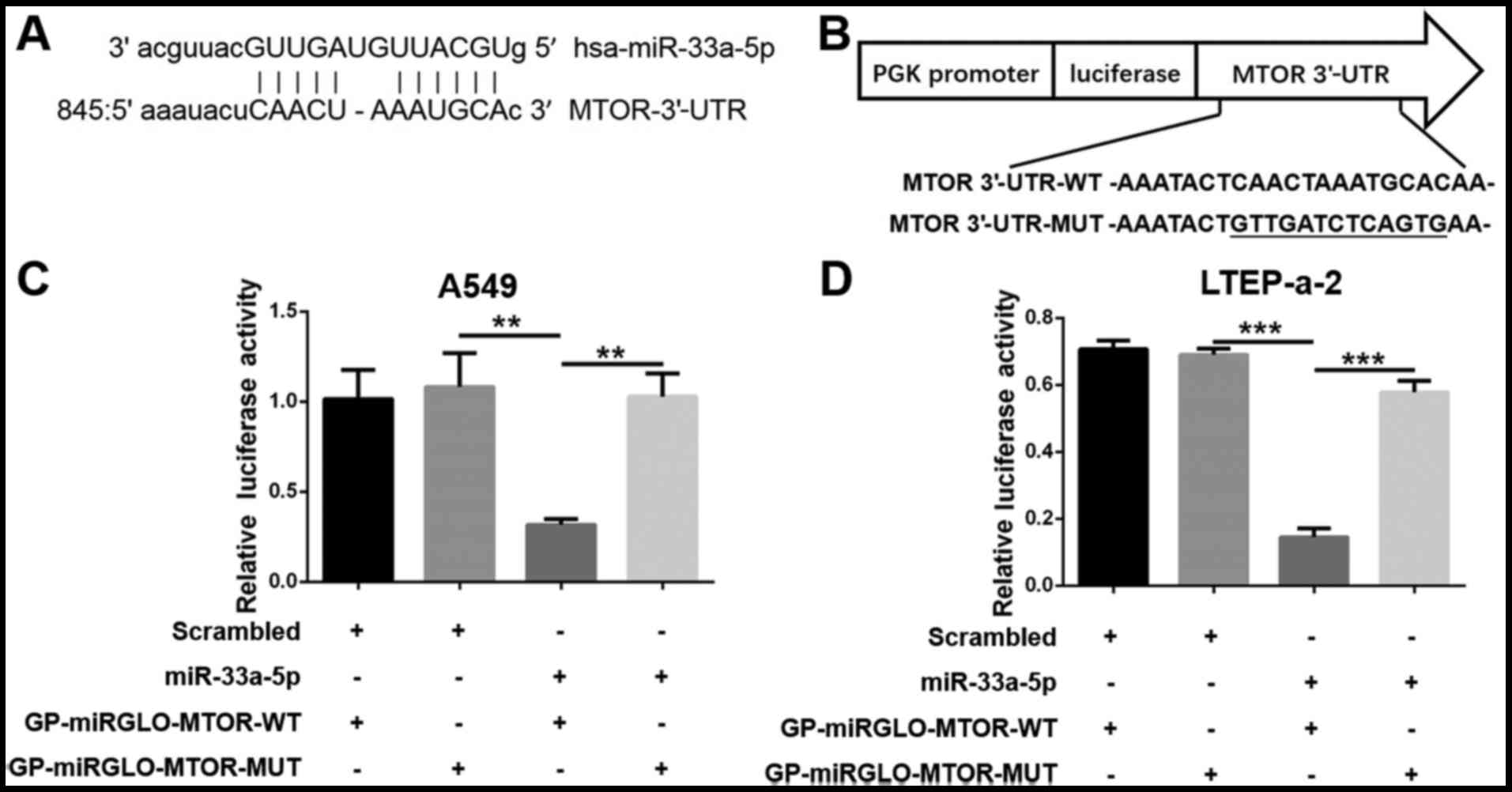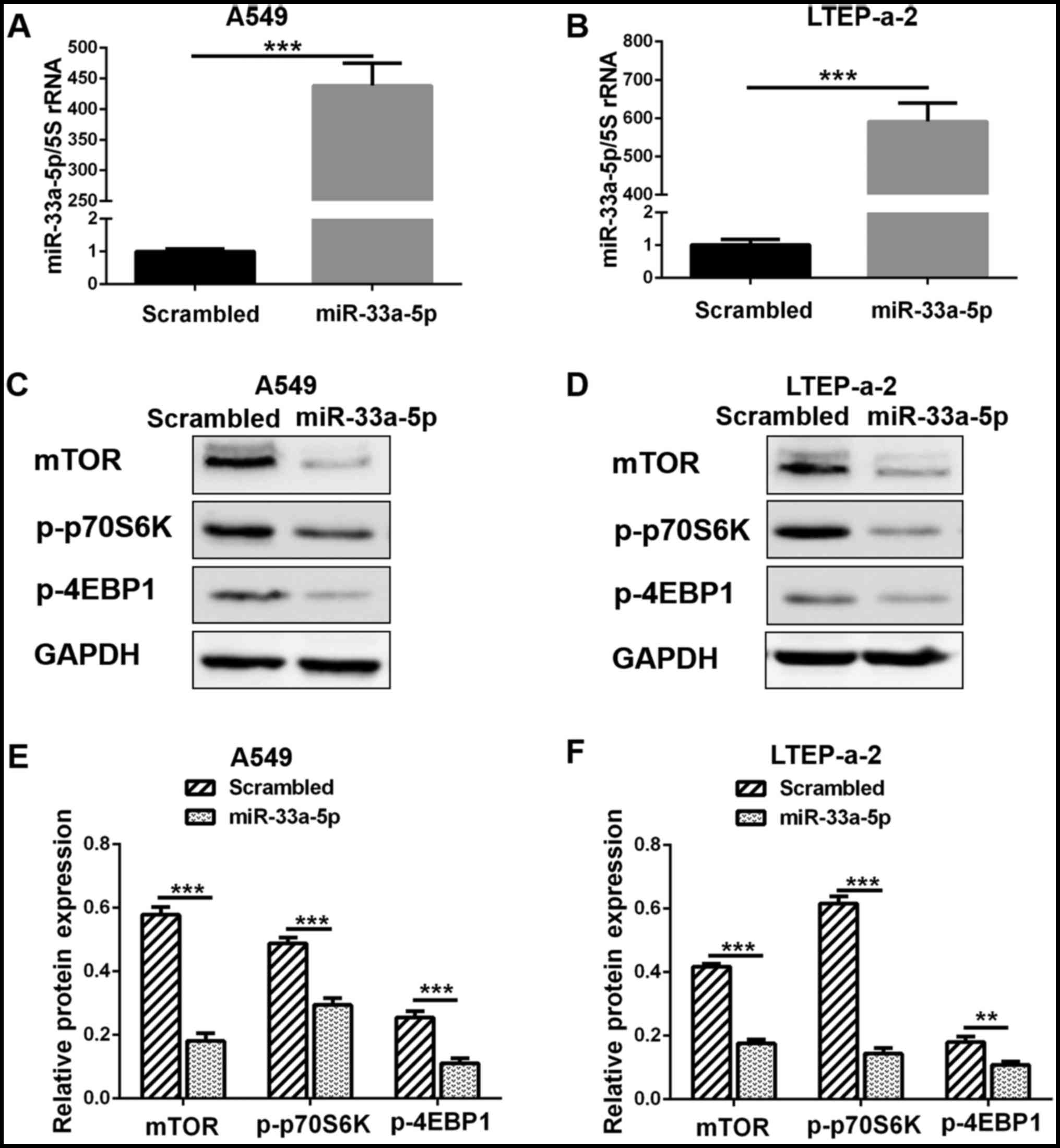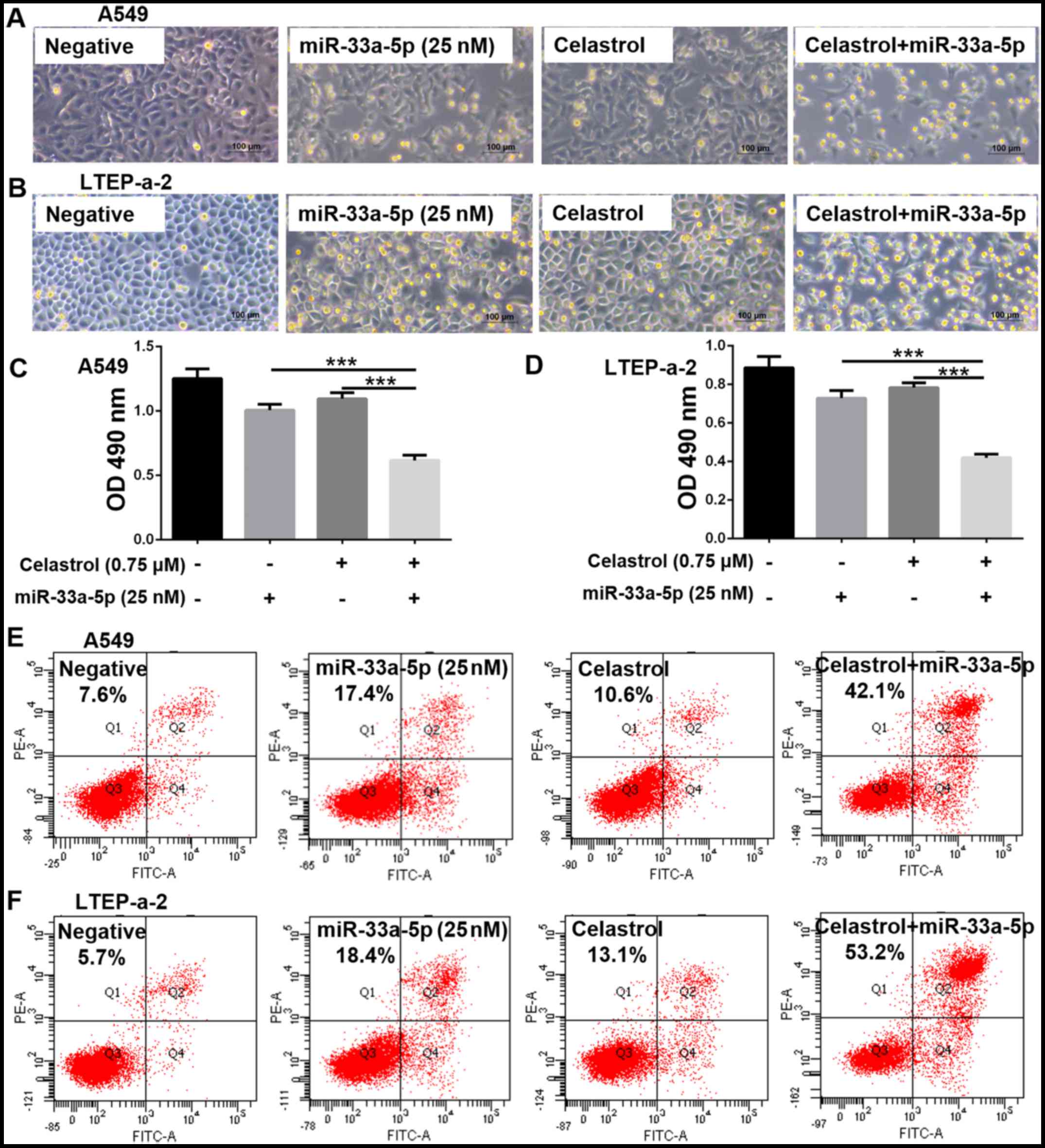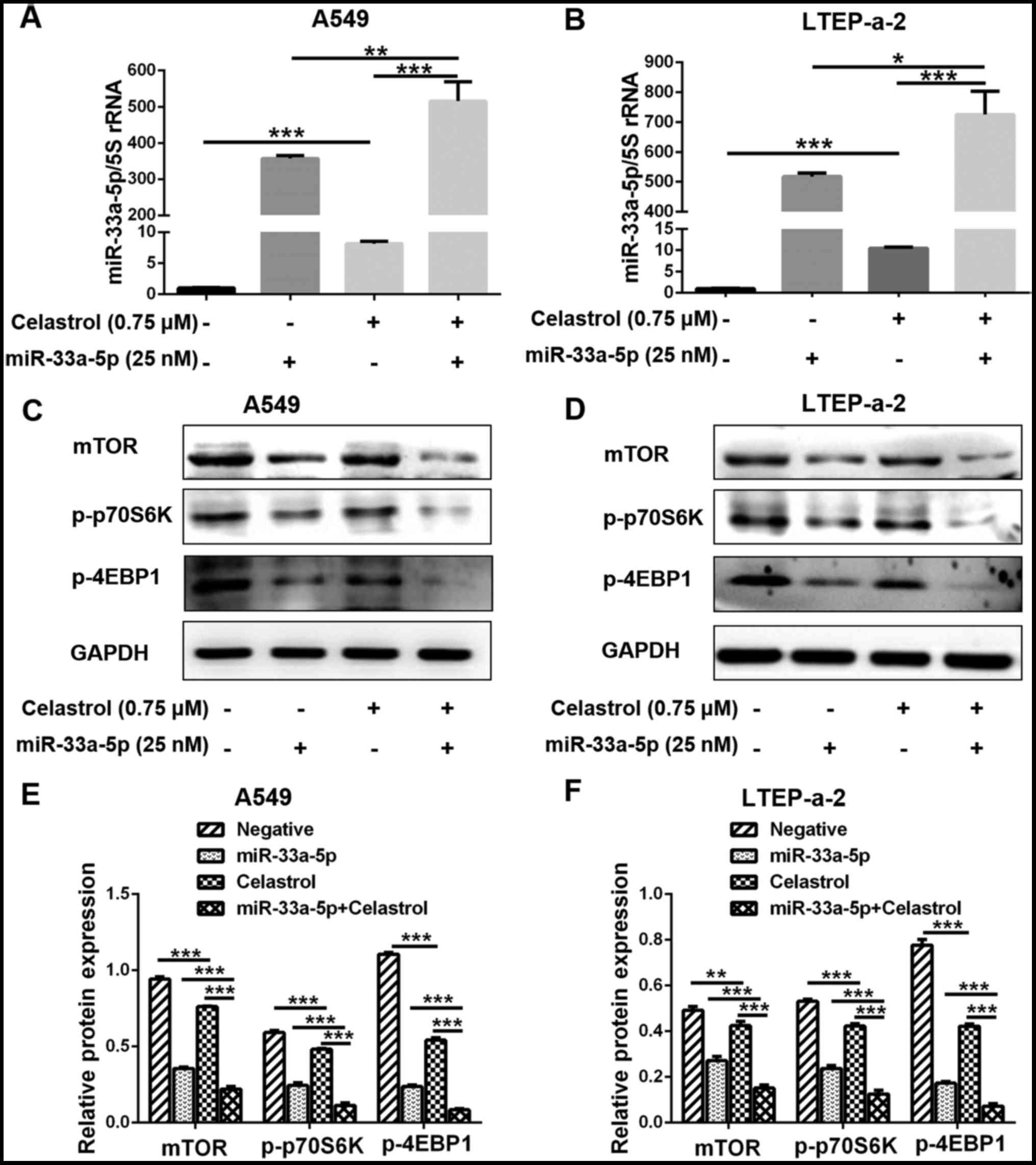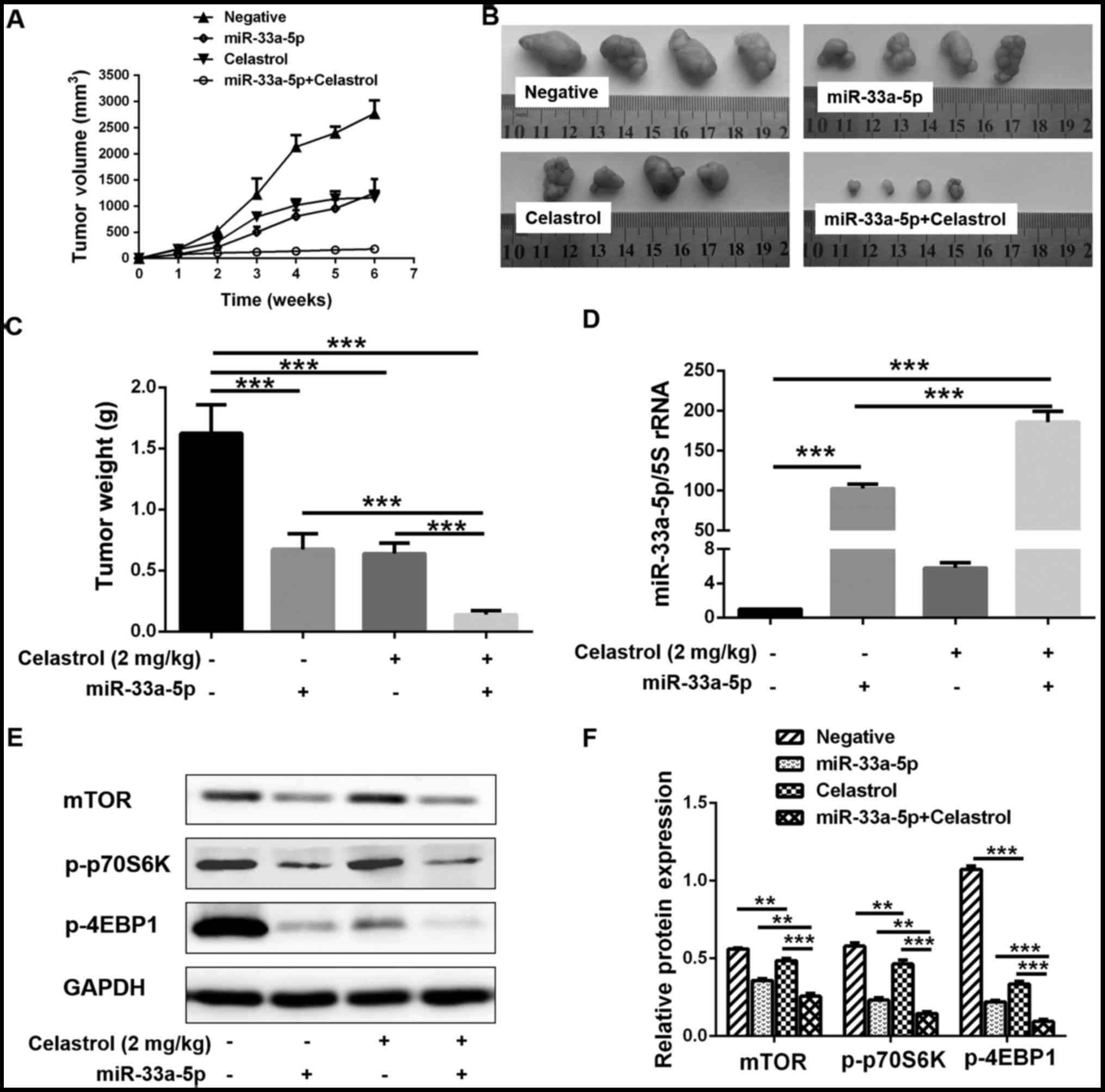miR-33a-5p enhances the sensitivity of lung adenocarcinoma cells to celastrol by regulating mTOR signaling
- Authors:
- Published online on: February 14, 2018 https://doi.org/10.3892/ijo.2018.4276
- Pages: 1328-1338
Abstract
Introduction
Lung cancer is a common malignant tumor type that has become a major public health concern globally. In a survey of 85.5 million people in China in 2015, the number of lung cancer cases was 7.333 million and the death toll was 6.102 million (1). Considerable progress in lung cancer treatment strategies, including surgery, radiation therapy and chemotherapy, has recently been achieved (2). However, lung cancer is characterized by high invasiveness, increased metastasis and drug resistance; hence, the survival rate of patients with this disease is poor (3). Thus, novel methods to treat lung cancer are urgently needed.
MicroRNAs (miRNAs or miRs) are small non-coding RNAs ~22 nucleotides long (4). miRNAs have recently become a popular focus of cancer research due to their ability to act as oncogenes or tumor suppressor genes. As regulators of gene expression, miRNAs repress protein translation or promote mRNA degradation by binding to the 3′-untranslated region (3′-UTR) of their target mRNAs (5,6). Selinexor may upregulate the expression of miR-145 by inhibiting exportin 1, which controls the proliferation and invasiveness of pancreatic cancer cells (7). This finding demonstrates that miRNAs may act as tumor suppressors. However, in gastric cancer cells, miR-181a-5p directly reduces the expression of protein-tyrosine phosphatase MEG2, which functions as a tumor suppressor gene, suggesting that this miRNA acts as an oncogene (8).
miR-33a is located in the sterol regulatory element-binding protein 2 gene of human chromosome 22 (9). miR-33a is the previous name of miR-33a-5p, which, together with miR-33a-3p, derives from the same pre-miRNA hairpin. miR-33a regulates the lipid balance effect by decreasing ATP binding cassette subfamily A member 1 and ATP binding cassette subfamily G member 1-mediated cholesterol efflux (10). In addition, as a tumor suppressor gene, miR-33a inhibits the proliferation and metastasis of breast cancer cells by suppressing a disintegrin and metalloproteinase domain 9 and ROS proto-oncogene 1 (4). Similarly, miR-33a may negatively regulate twist family bHLH transcription factor 1expression and inhibit lung cancer cellular metastasis in the SPC-A-1 and NCL-H1299 cell lines (11).
The anticancer effect of miRNAs has recently become a hot topic for research. Combining chemotherapeutic drugs with miRNAs has resulted in synergistic anticancer effects. In hepatocellular carcinoma (HCC) cells, miR-122 increases sensitivity to adriamycin and vincristine (12). Similarly, miR-145 improves sensitivity to paclitaxel (13). Celastrol, as an active compound, is extracted from Tripterygium wilfordii. Celastrol is an effective treatment for multiple diseases, including inflammation, neuropathic pain and atherosclerosis. Multiple studies have demonstrated that celastrol can modulate multiple signaling pathways involved in tumorigenesis, including tumor protein p53, androgen receptor/Ets transcription factor/nuclear factor-κB and caspase (14–16). Furthermore, celastrol has been reported to exhibit potential therapeutic efficacy against various types of cancer, including HCC, prostate and breast cancer (17–19). However, the exact anticancer mechanism of celastrol has not been fully elucidated. Based on the above studies, it was hypothesized that combining celastrol and miRNAs may be more effective in cancer treatment than either treatment alone. Therefore, the aim of the present study was to explore the mechanisms through which celastrol and miR-33a-5p may treat lung cancer. The results of the present study could provide the basis for a novel therapeutic approach for lung cancer.
Materials and methods
Lung adenocarcinoma tissues
Specimens of lung adenocarcinoma and paracarcinoma normal tissues were collected from 14 patients (7 males and 7 females, aged 40–59 years, 4 patients in stage IB and 10 patients in stage IIB) who were pathologically diagnosed with lung adenocarcinoma at YantaiShan Hospital (Yantai, China) between March 5 and August 31, 2015. All patients were diagnosed for the first time and had not received chemotherapy. Fresh tissues from the patients were prepared for RNA analysis immediately following surgery. All experiments were performed in accordance with the relevant guidelines and approved by the Medical Ethics Committee of Binzhou Medical University (Yantai, China). Prior to study inclusion, written informed consent was obtained from all patients.
Determination of miR-33a-5p expression by reverse transcription-quantitative polymerase chain reaction (RT-qPCR)
Specimens of lung adenocarcinoma and paracarcinoma tissues from 14 patients, and xenograft tumors from nude mice, were collected and ground into powder in liquid nitrogen; the cultured cells did not need to be homogenized. miRNAs from lung adenocarcinoma cells or tissues were isolated using a miRNA kit (Takara Bio, Inc., Otsu, Japan). After measuring the concentration of miRNAs, poly(A) was added using poly(A) polymerase (Ambion; Thermo Fisher Scientific, Inc., Waltham, MA, USA). Then, PrimeScript™ RT reagent kit with gDNA Eraser (Takara Bio, Inc.) was used to perform the RT reaction with primer [5′-AACATGTACAGTCCATGGATGd(T)30N(A, G, C or T)-3′]. The SYBR Premix Ex Taq kit (Takara Bio, Inc.) was used to perform qPCR with the 7500 Fast Real-Time PCR System (Applied Biosystems; Thermo Fisher Scientific, Inc.). The qPCR conditions were as follows: initial denaturation at 95°C for 30 sec; 40 cycles of 95°C for 10 sec, 60°C annealing for 20 sec and extension at 72°C for 20 sec. Then, fluorescence was detected at 585 nm. The primers used to amplify miR-33a-5p were 5′-GTGCATTGTAGTTGCATT-3′ (forward) and 5′-AACATGTACAGTCCATGGATG-3′ (reverse). The primers for 5S rRNA were 5′-GCCATACCACCCTGAACG-3′ (forward) and 5′-AACATGTACAGTCCATGGATG-3′ (reverse). The human 5S rRNA gene served as the control. The results were calculated using the 2−ΔΔCq value (20).
miRNA synthesis and vector construction
miR-33a-5p mimics and negative control (nc) oligonucleotides were chemically synthesized. The sequences of the miR-33a-5p mimics were as follows: GUGCAUUGUAGUUGCAUUGCA (sense) and UGCAAUGCAACUACAAUGCACUU (antisense). The sequences of the nc oligonucleotides were as follows: CAGUACUUUUGUGUAGUACAA (sense) and GUACUACACAAAAGUACUGUU (antisense). These sequences were inserted into the pGCMV/EGFP/miR/blasticidin vector during the construction of the miRNA overexpression vector. This part of the experiment was performed by GenePharma Biotech Co., Ltd. (Shanghai, China).
Cell culture and transfection
Lung adenocarcinoma (LTEP-a-2 and A549) cells and human bronchial epithelial (HBE) cells, which are all adherent cells, were maintained in 1640 medium supplemented with 10% fetal bovine serum (FBS) (both from Gibco; Thermo Fisher Scientific, Inc.), 100 U/ml penicillin, and 100 μg/ml streptomycin at 37°C with 5% CO2 under saturation humidity. The synthesized miRNA mimics were transfected when cells had reached 50–60% confluence. A total of 1 μg miRNA mimics was mixed with 3 μl Lipofectamine 2000 (Invitrogen; Thermo Fisher Scientific, Inc.), in accordance with the manufacturer's instructions. Cells were treated with 50 μM miRNA mimics. Blasticidin (Solarbio Science and Technology Co., Ltd., Beijing, China) was used to select antibiotic-resistant cells and to detect cells that expressed miR-33a-5p stably. Cells with stable miR-33a-5p expression were used for the xenograft experiments in mice. In addition, 0.75 μM celastrol (Sigma-Aldrich; Merck KGaA, Darmstadt, Germany) and 25 μM miRNA was used to detect the effects of combined treatment. Celastrol was added when changing the calf serum medium 6 h after transfection.
MTT assay to measure cell proliferation
Logarithmic-phase cells (1×104) in each well of 96-well plates were treated with miRNA or celastrol for 48 h. At 4 h before the end of incubation, 10 μl MTT (5 mg/ml; Sigma-Aldrich; Merck KGaA) was added to each well. Then, 100 μl DMSO (Sigma-Aldrich; Merck KGaA) was added, and the plate was shaken until MTT was dissolved. The optical density (OD) was measured at 490 nm using an auto-microplate reader (Thermo Fisher Scientific, Inc.) to compare the proliferation of each group of cells.
Flow cytometry to assess cellular apoptosis
Cells were treated with miRNA or celastrol for 48 h, and the culture medium was discarded. The cells were digested from the bottom of the culture flask with 0.25% trypsin enzyme without EDTA, then centrifuged at 100 × g for 5 min. PBS was used to wash the cells. The cellular apoptosis ratio was detected using Annexin V-fluorescein isothiocyanate (FITC)/propidium iodide (PI) staining (BD Pharmingen; BD Biosciences, Franklin Lakes, NJ, USA). Annexin V-FITC (5 μl) was added to the collected cells. After complete mixing, 5 μl PI was added. Finally, 1×104 cells were analyzed using a flow cytometer (Beckman Coulter, Inc., Brea, CA, USA). The data analysis was performed using the CytExpert 1.2.11.0 software (Beckman Coulter, Inc.).
Transwell cell migration assays
Cells were treated with miRNAs or celastrol for 24 h and collected. Then, the cells were seeded into the upper chamber (105 cells/well in 400 μl 1640 medium, FBS-free) of Transwells (Corning Inc., Corning, NY, USA). The lower chamber was filled with 600 μl 1640 medium supplemented with 20% calf serum (Gibco; Thermo Fisher Scientific, Inc.). After 24 h, the liquid in the upper chamber was removed with wet swabs, and the upper surface was carefully washed with methanol to fix the cells. Then, the cells that had traversed the membrane were stained with 0.1% crystal violet and counted under an inverted light microscope (Leica Microsystems GmbH, Wetzlar, Germany). The migration capability of the cells in vitro was assessed according to the number of transmembrane cells. Average trans-membrane cells number were determined in five ×200 fields.
Western blot analysis
Cells were lysed with lysis buffer (21), and all proteins were collected. The xenograft tumors were collected, ground into powder in liquid nitrogen, then lysed with lysis buffer to collect all proteins. Then, 40 μg protein was loaded into individual lanes and separated via SDS-PAGE. Subsequently, the proteins were transferred onto polyvinylidene fluoride membranes (Sigma-Aldrich; Merck KGaA), which were blocked with 7% nonfat milk in TBST for 2 h. After washing with TBST, the membranes were incubated with rabbit anti-human mTOR (1:800; cat. no. BS3611; Bioworld Technology, Nanjing, China), rabbit anti-human phosphorylated (p)-p70 ribosomal protein S6 kinase (p70S6K; 1:500; cat. no. BS4439), rabbit anti-human p-eukaryotic translation initiation factor 4E binding protein 1 (4EBP1; 1:500; cat. no. BS4746), and rabbit anti-human GAPDH (1:6,000; cat. no. AP0063) (all from Bioworld Technology) in TBST at 4°C overnight. Horseradish peroxidase-labeled goat anti-rabbit Immunoglobulin G (1:6,000; cat. no. ZB-2301; Beijing ZhongShan Golden Bridge Technology Co., Ltd., Beijing, China) was added, and the samples were incubated for 2 h at room temperature. Finally, images of the membranes were captured using a chemiluminescent imager (Tanon Science and Technology Co. Ltd., Shanghai, China). The densities of the bands were analyzed using Gel Image System 4.2 software (Tanon Science and Technology Co. Ltd.).
Luciferase assays
mTOR-3′-UTR double-stranded DNA (203 bp) containing an incomplete matched area of miR-33a-5p was synthesized and inserted into the dual-luciferase reporter pmirGLO vector (Promega Corp., Madison, WI, USA) by SacI/XhoI dual-enzyme digestion (Takara Bio, Inc.). Thus, GP-miRGLO-mTOR-WT was constructed. In addition, the nucleotide sequence was altered to construct the GP-miRGLO-mTOR-MUT vector as the control. A549 and LTEP-a-2 cells were transfected with miR-33a-5p and the dual-luciferase reporter pmirGLO vector, which simultaneously expressed the Firefly and Renilla luciferases. Cells were collected after 48 h incubation, and 100 μl 1X passive lysis buffer was added to each well. Then, 20 μl sample and 100 μl Luciferase Assay Reagent II were added to each well of 96-well white flat bottom plates. The activity of Firefly lucif-erase in each well was detected using a luminescent detection system (Tecan Group, Ltd., Mannedorf, Switzerland) read as M1. Then, 100 μl 1X Stop & Glo reagent was added to each well. The activity of Renilla luciferase was detected using the luminescent detection system, read as M2. The ratio of M1/M2 was calculated, and the relative luciferase activity of each group was evaluated.
Xenografts in mice
Cells were transfected with miR-33a-5p overexpression vector and selected with blasticidin. A total of 16 BALB/c-nu/nu 5-6 week-old male mice with an average weight of 18-20 g (Charles River, Beijing, China) were randomly divided into 4 groups of 4 mice in each. They were kept in a laminar airflow cabinet under specific pathogen-free conditions with a controlled temperature (23±2°C), humidity (40–70%) with free access to food and water. The cells were transplanted subcutaneously into the right or left flanks of these mice. Tumors appeared after ~3 days. The tumor volume was measured daily with calipers, with the following formula: Tumor volume (mm3) = A x B2/2, where 'A' and 'B' are the maximum and minimum tumor diameters, respectively. When the tumor volume of the control group increased to ~150 mm3, half of the mice from the control and the miRNA-overexpressing groups were randomly selected. Celastrol was injected into these selected mice at 2 mg/kg/day, 5 days/week. The other half of the groups was intraperitoneally injected with saline as a control. Following drug treatments for 6 weeks, all of the mice were sacrificed for tumor isolation by cervical vertebra dislocation. The tumors were then collected and weighed. Subsequently, all of the tumors were used for RNA extraction and total protein detection. All animal experiments were approved by the Committee on the Ethics of Animal Experiments of Binzhou Medical University and conducted based on the National Institutes of Health (Bethesda, MD, USA) Guide for the Care and Use of Laboratory Animals.
Statistical analysis
SPSS v22.0 software (IBM Corp., Armonk, NY, USA) was utilized for statistical analysis. Student's t-test and one-way analysis of variance followed by a Tukey's test were used to compare variables among groups. P<0.05 was considered to indicate a statistically significant difference.
Results
Expression of miR-33a-5p is low in lung cancer tissues and cells
The expression of miR-33a-5p was measured in lung tumors and the corresponding adjacent tissues to examine a potential role of miR-33a-5p on the development of lung adenocarcinoma. The results demonstrated that the expression levels of miR-33a-5p were significantly lower in lung cancer tissues compared with the corresponding adjacent tissues (Fig. 1A). When examining cell lines, the expression levels of miR-33a-5p were lower in the lung adenocarcinoma cell lines LTEP-a-2 and A549 compared with the normal HBE cells (Fig. 1B). Thus, downregulation of miR-33a-5p expression is likely to be involved in the development of lung adenocarcinoma.
miR-33a-5p inhibits the proliferation of lung adenocarcinoma cells
Considering the decrease in miR-33a-5p expression in lung adenocarcinoma tissues and cells, the effect of miR-33a-5p on the proliferation of lung adenocarcinoma cells was examined in vitro. At 48 h following transfection of miR-33a-5p mimics into A549 and LTEP-a-2 cells, a lower number of cells was observed in the miR-33a-5p overexpression group compared with the scrambled control group, in both the cell lines tested (Fig. 2A and B). In addition, MTT assay was used to measure cell viability. The OD value of the overexpression group was decreased compared with the scrambled control group (Fig. 2C and D), which indicated that cell proliferation in the overexpression group was inhibited. The results of the Transwell cell migration assays demonstrated that the migration ability of A549 and LTEP-a-2 cells was significantly inhibited following miR-33a-5p overexpression (Fig. 2E and F). Furthermore, miR-33a-5p overexpression enhanced apoptosis; the % of apoptotic cells was over four times higher in the miR-33a-5p overexpression group compared with the scrambled control group for both the A549 (Fig. 2G) and LTEP-a-2 (Fig. 2H) cells.
mTOR is a direct target of miR-33a-5p
A miRNA could inhibit the proliferation of lung adenocarcinoma cells by modulating the expression of its target genes. Therefore, predicted target genes were examined for miR-33a-5p by bioinformatics analysis (www.microrna.org/microrna/getMirnaForm.do and www.targetscan.org/index.html) and matching sites were identified on the 3′-UTR of the mTOR gene (Fig. 3A). According to the mechanism of miRNA function, miR-33a-5p likely affects the expression of mTOR by binding to the mTOR-3′-UTR. Wild-type (WT) mTOR-3′-UTR was cloned downstream of the Firefly luciferase gene to construct the GP-miRGLO-mTOR-WT dual-luciferase vector. In addition, the predicted binding sites (852-863 bp) were replaced with the complementary sequences to construct the mutant (MUT) GP-miRGLO-mTOR-MUT vector (Fig. 3B). The cells were transfected with the GP-miRGLO-mTOR-WT or GP-miRGLO-mTOR-MUT vector, together with miR-33a-5p mimics or scrambled control. Luciferase activity was detected after 48 h incubation. The results demonstrated that the relative luciferase activity significantly decreased in the cells transfected with the GP-miRGLO-mTOR-WT vector and miR-33a-5p mimics (Fig. 3C and D). No notable difference was observed between cells transfected with GP-miRGLO-mTOR-MUT vector and miR-33a-5p mimics (Fig. 3C and D).
miR-33a-5p negatively regulates mTOR and downstream effector expression in lung adenocarcinoma cells
The effect of miR-33a-5p transfection on mTOR expression in lung adenocarcinoma cells was determined. RT-qPCR analysis confirmed that the expression levels of miR-33a-5p significantly increased in the A549 and LTEP-a-2 cells following mimics transfection (Fig. 4A and B). The results from the western blot analysis of the transfected cells indicated that the protein expression levels of mTOR were significantly inhibited following miR-33a-5p overexpression (Fig. 4C–F). Furthermore, the protein expression levels for the downstream effectors of mTOR, p-p70S6K and p-4EBP1, were significantly decreased following miR-33a-5p overexpression (Fig. 4C–F). These results indicated that miR-33a-5p inhibited the proliferation of lung adenocarcinoma cells via the mTOR signaling pathway.
miR-33a-5p enhances cellular sensitivity to celastrol
Celastrol treatment was combined with miR-33a-5p overexpression and microscopic observation of the cells revealed that the number of visible living cells was significantly reduced in the combination treatment group compared with the negative control group, and the single-use 0.75 μM celastrol or 25 nM miR-33a-5p groups (Fig. 5A and B). In the MTT assay, the OD of the combination treatment group was lower compared with the other groups, which indicated a reduction in cell viability (Fig. 5C and D). Therefore, the combination treatment inhibited cell proliferation more efficiently than either treatment alone. The % of apoptotic cells in the A549 and LTEP-a-2 cells was ~50% in the combination treatment group, but <20% in the single treatment groups (Fig. 5E and F).
Combination of celastrol and miR-33a-5p increases the expression of miR-33a-5p to inhibit the mTOR signaling pathway
The expression levels of miR-33a-5p were examined by RT-qPCR, in order to explore the mechanism by which miR-33a-5p enhances the sensitivity of lung adenocarcinoma cells to celastrol. Although miR-33a-5p expression was increased in the celastrol alone group, it was considerably higher in the celastrol and miR-33a-5p combination treatment group (Fig. 6A and B). Furthermore, results from western blot analysis demonstrated that the expression of mTOR was markedly decreased in the combination treatment group as the expression of miR-33a-5p increased (Fig. 6D–F). Similarly, p-p70S6K and p-4EBP1 expression was also further decreased in the combination treatment group (Fig. 6D–F). These results suggested that mTOR was involved in the mechanism by which miR-33a-5p enhanced the sensitivity of lung adenocarcinoma cells to celastrol. The results were similar in A549 (Fig. 6C and E) and LTEP-a-2 (Fig. 6D and F) cells.
Combination of celastrol and miR-33a-5p inhibits LTEP-a-2 cell growth in vivo
Parental untreated LTEP-a-2 cells (negative) or LTEP-a-2 cells stably transfected with miR-33a-5p overexpression vector (miR-33a-5p) were injected into the flanks of nude mice. Mice were then administered with celastrol or saline treatment to verify that the combination of celastrol and miR-33a-5p could inhibit LTEP-a-2 cell growth in vivo. The growth curve of the xenograft tumors revealed that the tumor volume increased with prolonged incubation time in the negative control group. The tumor growth rate was considerably lower in the celastrol treatment alone group or the miR-33a-5p overexpression alone group compared with the negative control group. In the combination treatment group, the tumor growth was almost completely arrested after 2 weeks (Fig. 7A). The xenograft tumors were extracted at the end of the experiment and the volumes and weight measurements of the xenograft tumors varied among the different groups (Fig. 7B and C). The xenograft tumors in the combination treatment group were the smallest (Fig. 7B and C). RT-qPCR analysis of the xenograft tumors indicated that the cells stably transfected with the miR-33a-5p overexpression vector maintained a higher expression level of miR-33a-5p compared with the parental cells (Fig. 7D). Celastrol treatment further enhanced the expression of miR-33a-5p (Fig. 7D), which was consistent with the in vitro experiments. Finally, similarly to the in vitro experiments, higher expression levels of miR-33a-5p resulting from the combination treatment significantly inhibited the expression of mTOR and its downstream effectors in the xenograft tumors (Fig. 7E and F).
Discussion
As small noncoding RNA molecules, miRNAs have vital roles in various cellular processes during cancer development, such as proliferation, apoptosis, invasion and migration (22,23). miRNAs may function as tumor oncogenes or suppressors (24). As an oncogene, miR-374a overexpression significantly promotes HCC cell viability compared with control. Further investigation indicated that miR-374a enhances HCC proliferation by targeting mitogen-inducible gene 6 (25). Conversely, researchers have discovered that miRNAs may act as tumor suppressors by inhibiting proliferation and promoting apoptosis. miR-133b expression is significantly lower in colorectal cancer (CRC) samples or cell lines compared with normal controls. In addition, transfection with miR-133b can markedly hinder CRC cell proliferation and invasion in vitro and in vivo (26). The expression of miR-140-5p is reduced five-fold in breast cancer tissues compared with adjacent normal tissues, and is associated with advanced clinical procedure and poor prognosis (27). In the present study, miR-33a-5p expression was demonstrated to be decreased in lung adenocarcinoma tissues compared with normal adjacent tissues. Similarly, miR-33a-5p expression was reduced in lung adenocarcinoma cell lines compared with normal HBE cells. These results indicated miR-33a-5p may act as a tumor suppressor gene.
Previous studies have reported that miR-33a-5p has a critical role in tumor growth and proliferation. Wang et al (28) determined that miR-33a acts as a cell proliferation suppressor in gastric cancer by targeting CDK6, cyclin D1 and Pim-1 proto-oncogene serine/threonine protein kinase. However, other researchers have reported different findings on the function of miR-33a-5p in tumors. miR-33a promotes the proliferation and inhibits the apoptosis of liver cancer cells by targeting peroxisome proliferator-activated receptor-α (29). In order to explore the function of miR-33a-5p in lung adenocarcinoma, lung adenocarcinoma cells were transfected with miR-33a-5p mimics. The results demonstrated that upregulating the expression of miR-33a-5p could markedly inhibit the growth of the lung adenocarcinoma cell lines.
It is widely believed that miRNAs can regulate protein expression by binding to the 3′-UTR of mRNA (8,30,31). mTOR is a serine/threonine kinase that is involved in the growth and proliferation of cancer cells (32). Previous studies have demonstrated that mTOR can promote the activation of p70S6K and the phosphorylation of 4E-BP1, which is closely related to tumor growth and proliferation (33,34). In the present study, miRNA target prediction software was employed and a luciferase reporter assay was conducted to further analyze the relationship between miR-33a-5p and mTOR. The miRNA target prediction software indicated that multiple miR-33a-5p binding sites are located in the mTOR 3′-UTR. miR-33a-5p was demonstrated to directly target mTOR, as evidenced by the luciferase reporter assay results. In addition, overexpression of miR-33a-5p significantly decreased the protein expression levels of mTOR, thereby weakening the phosphorylation of p70S6K and 4EBP1. Other studies have demonstrated that many other proteins can also be targeted by miR-33a-5p. As a tumor suppressor, miR-33a can downregulate PIM1 by directly targeting its 3′-UTR in prostate cancer (35). Similarly, in melanoma cells, miR-33a, whose target is CDK16, is an important negative regulator of cell proliferation (36). In addition, as a bone metastasis suppressor in lung cancer, miR-33a targets parathyroid hormone-related protein (37).
As a chemotherapeutic drug, celastrol not only inhibits cancer cell proliferation, but also regulates miRNA expression. In prostate cancer cells, celastrol downregulates miR-17-92a, which can lead to autophagy induction (38). Similarly, celastrol inhibits HCC cell migration and invasion by regulating miR-224 expression (39). In the current study, miR-33a-5p was demonstrated to be upregulated in lung adenocarcinoma cells following celastrol treatment. Therefore, we focused on the effect of the combined celastrol and miR-33a-5p treatment on lung adenocarcinoma cells. There is considerable evidence supporting the benefits of combining chemotherapeutic drugs and miRNAs. miR-223 improved the sensitivity of gallbladder cancer cells to docetaxel by downregulating stathmin 1 (40). Similarly, miR-101 enhances the cytotoxic effects of fluorouracil and cisplatin by inhibiting the proliferation of colon cancer cells (41). In the present study, compared with the miR-33a-5p or celastrol alone groups, the group administered with combined miR-33a-5p and celastrol treatments exhibited higher proliferation inhibition and apoptosis rates, as determined by MTT and flow cytometry analyses, respectively. Western blot analysis demonstrated that the combination treatment group also had low expression levels of mTOR and its downstream effectors. Similar results were observed in the xenografted animal model. The present data suggest that combined treatment with celastrol and miR-33-5p exerted a more notable effect on lung adenocarcinoma compared with either treatment alone. However, isobologram analysis was not performed in the present study, as the IC50 of the miRNA-mediated inhibitory effect on cell growth is difficult to calculate; similarly, other previous studies examining the combination of miRNA and chemical in the treatment of cancer also did not perform isobologram analysis (40,42).
In conclusion, miR-33a-5p overexpression inhibited the proliferation of lung adenocarcinoma cells and enhanced the anticancer effects of celastrol. In addition, miR-33a-5p improved the sensitivity of lung adenocarcinoma cells to celastrol by targeting the mTOR signaling pathway. Therefore, a combination of miR-33a-5p and celastrol treatment may be a promising therapeutic strategy for patients with lung adenocarcinoma.
Glossary
Abbreviations
Abbreviations:
|
miRNA |
microRNA |
|
mTOR |
mechanistic target of rapamycin |
|
UTR |
untranslated region |
|
p70S6K |
p70 ribosomal protein S6 kinase |
|
4EBP1 |
eukaryotic translation initiation factor 4E binding protein 1 |
|
RT-qPCR |
reverse transcription-quantitative polymerase chain reaction |
|
DMSO |
dimethyl sulfoxide |
|
OD |
optical density |
|
HCC |
hepatocellular carcinoma |
|
CRC |
colorectal cancer |
|
CDK |
cyclin-dependent kinase |
Acknowledgments
Not applicable.
Notes
[1] Funding
The present study was supported by the National Natural Science Foundation (grant nos. 31371321, 81572735 and 81772281), the Shandong Science and Technology Committee (grant nos. ZR2014HQ079, ZR2014HL056 and ZR2013HL003), and the Foundation of Shandong Educational Committee (grant nos. J17KA121 and J13LE11).
[2] Availability of data and materials
The analyzed datasets generated during the study are available from the corresponding author on reasonable request.
[3] Author's contributions
YJL, WC and SYX conceived and designed the experiments. YJL, YXS, RMH, PW, LJZ, XM, YM, PYW and NX performed the experiments. YJL, PYW, SYX and WC analyzed the data. YJL, YXS, SYX and WC wrote the manuscript. All authors have read and approved the final manuscript.
[4] Ethics approval and consent to participate
All experiments with human specimens were performed in accordance with the relevant guidelines and approved by the Medical Ethics Committee of Binzhou Medical University (Yantai, China). Prior to study inclusion, written informed consent was obtained from all patients. All animal experiments were approved by the Committee on the Ethics of Animal Experiments of Binzhou Medical University and conducted based on the National Institutes of Health (Bethesda, MD, USA) Guide for the Care and Use of Laboratory Animals.
[5] Consent for publication
Not applicable.
[6] Competing interests
The authors declare that they have no competing interests.
References
|
Chen W, Zheng R, Baade PD, Zhang S, Zeng H, Bray F, Jemal A, Yu XQ and He J: Cancer statistics in China, 2015. CA Cancer J Clin. 66:115–132. 2016. View Article : Google Scholar : PubMed/NCBI | |
|
Ettinger DS, Wood DE, Akerley W, Bazhenova LA, Borghaei H, Camidge DR, Cheney RT, Chirieac LR, D'Amico TA, Demmy TL, et al: Non-small cell lung cancer, version 1. J Natl Compr Canc Netw. 12:1738–1761. 2015. View Article : Google Scholar | |
|
Tan CS, Gilligan D and Pacey S: Treatment approaches for EGFR-inhibitor-resistant patients with non-small-cell lung cancer. Lancet Oncol. 16:e447–e459. 2015. View Article : Google Scholar : PubMed/NCBI | |
|
Zhang C, Zhang Y, Ding W, Lin Y, Huang Z and Luo Q: MiR-33a suppresses breast cancer cell proliferation and metastasis by targeting ADAM9 and ROS1. Protein Cell. 6:881–889. 2015. View Article : Google Scholar : PubMed/NCBI | |
|
Pu M, Li C, Qi X, Chen J, Wang Y, Gao L, Miao L and Ren J: MiR-1254 suppresses HO-1 expression through seed region-dependent silencing and non-seed interaction with TFAP2A transcript to attenuate NSCLC growth. PLoS Genet. 13:e10068962017. View Article : Google Scholar : PubMed/NCBI | |
|
Guo X, Zhu Y and Hong X, Zhang M, Qiu X, Wang Z, Qi Z and Hong X: miR-181d and c-myc-mediated inhibition of CRY2 and FBXL3 reprograms metabolism in colorectal cancer. Cell Death Dis. 8:e29582017. View Article : Google Scholar : PubMed/NCBI | |
|
Azmi AS, Li Y, Muqbil I, Aboukameel A, Senapedis W, Baloglu E, Landesman Y, Shacham S, Kauffman MG, Philip PA, et al: Exportin 1 (XPO1) inhibition leads to restoration of tumor suppressor miR-145 and consequent suppression of pancreatic cancer cell proliferation and migration. Oncotarget. 8:82144–82155. 2017. View Article : Google Scholar : PubMed/NCBI | |
|
Liu Z, Sun F, Hong Y, Liu Y, Fen M, Yin K, Ge X, Wang F, Chen X and Guan W: MEG2 is regulated by miR-181a-5p and functions as a tumour suppressor gene to suppress the proliferation and migration of gastric cancer cells. Mol Cancer. 16:1332017. View Article : Google Scholar : PubMed/NCBI | |
|
Najafi-Shoushtari SH, Kristo F, Li Y, Shioda T, Cohen DE, Gerszten RE and Näär AM: MicroRNA-33 and the SREBP host genes cooperate to control cholesterol homeostasis. Science. 328:1566–1569. 2010. View Article : Google Scholar : PubMed/NCBI | |
|
Mao M, Lei H, Liu Q, Chen Y, Zhao L, Li Q, Luo S, Zuo Z, He Q, Huang W, et al: Effects of miR-33a-5P on ABCA1/G1-mediated cholesterol efflux under inflammatory stress in THP-1 macrophages. PLoS One. 9:e1097222014. View Article : Google Scholar : PubMed/NCBI | |
|
Yang L, Yang J, Li J, Shen X, Le Y, Zhou C, Wang S, Zhang S, Xu D and Gong Z: MircoRNA-33a inhibits epithelial-to-mesenchymal transition and metastasis and could be a prognostic marker in non-small cell lung cancer. Sci Rep. 5:136772015. View Article : Google Scholar : PubMed/NCBI | |
|
Xu Y, Xia F, Ma L, Shan J, Shen J, Yang Z, Liu J, Cui Y, Bian X, Bie P, et al: MicroRNA-122 sensitizes HCC cancer cells to adri-amycin and vincristinethrough modulating expression of MDR and inducing cell cycle arrest. Cancer Lett. 310:160–169. 2011.PubMed/NCBI | |
|
Zhu X, Li Y, Xie C, Yin X, Liu Y, Cao Y, Fang Y, Lin X, Xu Y, Xu W, et al: miR-145 sensitizes ovarian cancer cells to paclitaxel by targeting Sp1 and Cdk6. Int J Cancer. 135:1286–1296. 2014. View Article : Google Scholar : PubMed/NCBI | |
|
Wang R, Gu X, Dai W, Ye J, Lu F, Chai Y, Fan G, Gonzalez FJ, Duan G and Qi Y: A lipidomics investigation into the intervention of celastrol in experimental colitis. Mol Biosyst. 12:1436–1444. 2016. View Article : Google Scholar : PubMed/NCBI | |
|
Yang L, Li Y, Ren J, Zhu C, Fu J, Lin D and Qiu Y: Celastrol attenuates inflammatory and neuropathic pain mediated by cannabinoid receptor type 2. Int J Mol Sci. 15:13637–13648. 2014. View Article : Google Scholar : PubMed/NCBI | |
|
Gu L, Bai W, Li S, Zhang Y, Han Y, Gu Y, Meng G, Xie L, Wang J, Xiao Y, et al: Celastrol prevents atherosclerosis via inhibiting LOX-1 and oxidative stress. PLoS One. 8:e654772013. View Article : Google Scholar : PubMed/NCBI | |
|
Chang W, He W, Li PP, Song SS, Yuan PF, Lu JT and Wei W: Protective effects of celastrol on diethylnitrosamine-induced hepatocellular carcinoma in rats and its mechanisms. Eur J Pharmacol. 784:173–180. 2016. View Article : Google Scholar : PubMed/NCBI | |
|
Shao L, Zhou Z, Cai Y, Castro P, Dakhov O, Shi P, Bai Y, Ji H, Shen W and Wang J: Celastrol suppresses tumor cell growth through targeting an AR-ERG-NF-κB pathway in TMPRSS2/ERG fusion gene expressing prostate cancer. PLoS One. 8:e583912013. View Article : Google Scholar | |
|
Yang HS, Kim JY, Lee JH, Lee BW, Park KH, Shim KH, Lee MK and Seo KI: Celastrol isolated from Tripterygium regelii induces apoptosis through both caspase-dependent and -independent pathways in human breast cancer cells. Food Chem Toxicol. 49:527–532. 2011. View Article : Google Scholar | |
|
Livak KJ and Schmittgen TD: Analysis of relative gene expression data using real-time quantitative PCR and the 2(−Delta Delta C(T)) methods. Methods. 25:402–408. 2001. View Article : Google Scholar | |
|
Zhang X, Chen S and Wang Y: Honokiol up-regulates prostacyclin synthease protein expression and inhibits endothelial cell apoptosis. Eur J Pharmacol. 554:1–7. 2007. View Article : Google Scholar | |
|
Labak CM, Wang PY, Arora R, Guda MR, Asuthkar S, Tsung AJ and Velpula KK: Glucose transport: Meeting the metabolic demands of cancer, and applications in glioblastoma treatment. Am J Cancer Res. 6:1599–1608. 2016.PubMed/NCBI | |
|
Jiang R, Zhang C, Liu G, Gu R and Wu H: MicroRNA-101 inhibits proliferation, migration and invasion in osteosarcoma cells by targeting ROCK1. Am J Cancer Res. 7:88–97. 2017.PubMed/NCBI | |
|
Baranwal and Alahari SK: miRNA control of tumor cell invasion and metastasis. Int J Cancer. 126:1283–1290. 2010. | |
|
Li H, Chen H, Wang H, Dong Y, Yin M, Zhang L and Wei J: MicroRNA-374a promotes hepatocellular carcinoma cell proliferation by targeting mitogen-inducible gene-6 (MIG-6). Oncol Res. Jul 21–2017.Epub ahead of print. View Article : Google Scholar | |
|
Wang X, Bu J, Liu X, Wang W, Mai W, Lv B, Zou J, Mo X, Li X, Wang J, et al: miR-133b suppresses metastasis by targeting HOXA9 in human colorectal cancer. Oncotarget. 8:63935–63948. 2017.PubMed/NCBI | |
|
Lu Y, Qin T, Li J, Wang L, Zhang Q, Jiang Z and Mao J: MicroRNA-140-5p inhibits invasion and angiogenesis through targeting VEGF-A in breast cancer. Cancer Gene Ther. 24:386–392. 2017. View Article : Google Scholar : PubMed/NCBI | |
|
Wang Y, Zhou X, Shan B, Han J, Wang F, Fan X, Lv Y, Chang L and Liu W: Downregulation of microRNA-33a promotes cyclin-dependent kinase 6, cyclin D1 and PIM1 expression and gastric cancer cell proliferation. Mol Med Rep. 12:6491–6500. 2015. View Article : Google Scholar : PubMed/NCBI | |
|
Chang W, Zhang L, Xian Y and Yu Z: MicroRNA-33a promotes cell proliferation and inhibits apoptosis by targeting PPARα in human hepatocellular carcinoma. Exp Ther Med. 13:2507–2514. 2017. View Article : Google Scholar : PubMed/NCBI | |
|
Wei F, Ma C, Zhou T, Dong X, Luo Q, Geng L, Ding L, Zhang Y, Zhang L, Li N, et al: Exosomes derived from gemcitabine-resistant cells transfer malignant phenotypic traits via delivery of miRNA-222-3p. Mol Cancer. 16:1322017. View Article : Google Scholar : PubMed/NCBI | |
|
Li JA, Wang YD, Wang K, Wang ZL, Jia DY, Yang BY and Xiong CB: Downregulation of miR-214-3p may contribute to pathogenesis of ulcerative colitis via targeting STAT6. BioMed Res Int. 2017:85249722017.PubMed/NCBI | |
|
Perl A: mTOR activation is a biomarker and a central pathway to autoimmune disorders, cancer, obesity, and aging. Ann NY Acad Sci. 1346:33–44. 2015. View Article : Google Scholar : PubMed/NCBI | |
|
Lekmine F, Uddin S, Sassano A, Parmar S, Brachmann SM, Majchrzak B, Sonenberg N, Hay N, Fish EN and Platanias LC: Activation of the p70 S6 kinase and phosphorylation of the 4E-BP1 repressor of mRNA translation by type I interferons. J Biol Chem. 278:27772–27780. 2003. View Article : Google Scholar : PubMed/NCBI | |
|
Mi C, Ma J, Wang KS, Zuo HX, Wang Z, Li MY, Piao LX, Xu GH, Li X, Quan ZS, et al: Imperatorin suppresses proliferation and angiogenesis of human colon cancer cell by targeting HIF-1α via the mTOR/p70S6K/4E-BP1 and MAPK pathways. J Ethnopharmacol. 203:27–38. 2017. View Article : Google Scholar : PubMed/NCBI | |
|
Karatas OF, Wang J, Shao L, Ozen M, Zhang Y, Creighton CJ and Ittmann M: miR-33a is a tumor suppressor microRNA that is decreased in prostate cancer. Oncotarget. 8:60243–60256. 2017. View Article : Google Scholar : PubMed/NCBI | |
|
Tian F, Wei H, Tian H, Qiu Y and Xu J: miR-33a is downregulated in melanoma cells and modulates cell proliferation by targeting PCTAIRE1. Oncol Lett. 11:2741–2746. 2016. View Article : Google Scholar : PubMed/NCBI | |
|
Kuo PL, Liao SH, Hung JY, Huang MS and Hsu YL: MicroRNA-33a functions as a bone metastasis suppressor in lung cancer by targeting parathyroid hormone related protein. Biochim Biophys Acta. 1830:3756–3766. 2013. View Article : Google Scholar : PubMed/NCBI | |
|
Guo J, Mei Y, Li K, Huang X and Yang H: Downregulation of miR-17-92a cluster promotes autophagy induction in response to celastrol treatment in prostate cancer cells. Biochem Biophys Res Commun. 478:804–810. 2016. View Article : Google Scholar : PubMed/NCBI | |
|
Li H, Li Y, Liu D, Sun H and Liu J: miR-224 is critical for celastrol-induced inhibition of migration and invasion of hepatocellular carcinoma cells. Cell Physiol Biochem. 32:448–458. 2013. View Article : Google Scholar : PubMed/NCBI | |
|
Lu W, Hu Y, Ma Q, Zhou L, Jiang L, Li Z, Zhao S, Xu Y, Shi W, Li S, et al: miR-223 increases gallbladder cancer cell sensitivity to docetaxel by downregulating STMN1. Oncotarget. 7:62364–62376. 2016. View Article : Google Scholar : PubMed/NCBI | |
|
Chen LG, Xia YJ and Cui Y: Upregulation of miR-101 enhances the cytotoxic effect of anticancer drugs through inhibition of colon cancer cell proliferation. Oncol Rep. 38:100–108. 2017. View Article : Google Scholar : PubMed/NCBI | |
|
Asukai K, Kawamoto K, Eguchi H, Konno M, Asai A, Iwagami Y, Yamada D, Asaoka T, Noda T, Wada H, et al: Micro-RNA-130a-3p regulates gemcitabine resistance via PPARG in cholangiocarcinoma. Ann Surg Oncol. 24:2344–2352. 2017. View Article : Google Scholar : PubMed/NCBI |



